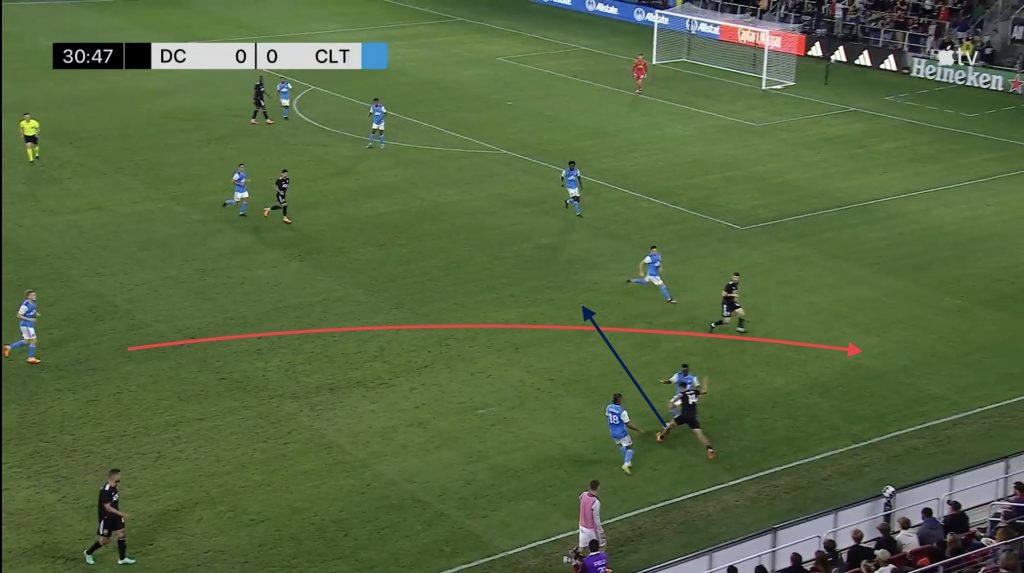D.C. United will roll into TQL Stadium on Saturday on the back of four wins on the trot. However, one of those wins was against USL side Richmond Kickers, and the other three came against opponents with a combined record of 9-14-5. It’s tough to tell whether Wayne Rooney’s squad has turned a corner since his shift to a 3-5-2 and a more direct style of play, or if they’ve just been capitalizing by winning over opponents who aren’t very good.
Though I can’t be certain, I’d guess that we’ll see D.C. United stick with the 3-5-2 that they’ve employed in their last two wins, as well as a hefty dose of long balls into Christian Benteke.
For more soccer content like this, follow me on Twitter (@FCCincyTacTalk).
Team: DC United
Matches Scouted: 4/22/23 at Orlando City; 4/29/23 vs. Charlotte
Formation: 5-3-2
Mode of Attack
D.C. United doesn’t stick entirely to the long ball. In fact, they favor playing the ball around the back and probing the outsides of the field. They love to run one of their dual 8’s (Lewis O’Brien and Mateusz Klich) toward the outside of the pitch to create overloads. Typically, Klich makes runs to the right and O’Brien to the left. Taxi Fountas will also make runs to the corner.
However, when this style of possession isn’t panning out, and from virtually every restart, United’s default is to hit a long ball toward Benteke and look for the big target forward to knock the ball down or flick it on. Benteke is big, strong and wins his fair share of aerial duels. However, he isn’t particularly adept at playing with his feet. Therefore, he is mostly looking to play one or two touch and direct the ball toward a teammate rather than really holding it up and bringing them into play.
Method of Chance Creation
As mentioned above, D.C. United loves to create overloads out wide by using a central midfielder running into the half-space or toward the corner. Klich is especially good at finding space on the right side from which to turn provider. When they can’t play directly up the line in this way, they will typically look for a central player (often Benteke) to play through in order to get the ball to a wingback. From there, they love to play for crosses and cutbacks to create chances.
United also relies quite a bit on individual skill to create shots. Especially when Andy Najar starts at right wingback, they are not afraid to spread the field out and try to get players in 1v1 situations in order to dribble their way into dangerous areas. The image below puts these ideas together, as Klich makes a run to the corner dragging a defender and giving Najar the opportunity to beat his man on the dribble to the inside.

Klich makes a run from midfield giving Najar the space to dribble inside.
Mode of Defense
United falls back to defend in a very compact 5-3-2. Their central midfielders are more of a flat 3 than a triangle. They look to funnel the ball wide, then use two midfielders and the wingback and center back on the ball side to squeeze space. The 3rd midfielder stays centrally and tries to prevent the ball from being switched to the other side. When defending in the middle and attacking thirds, they will press at times, usually when the opponent plays a back pass.
The image below is the shot zone chart from United’s match with Charlotte. Notice how the majority of D.C.’s shots came from inside the box (via crosses) while their compact defense forced Charlotte into shooting from distance.

This chart shows that D.C. United creates most of their opportunities inside the box, via crosses, while forcing their opponents to more often shoot from distance.
Mode of Transition
D.C. United doesn’t typically look to transition forward quickly unless Ruan is on the right and happens to be on his bike. Instead, they look to immediately get the ball into space and then keep possession. However, they will occasionally try to hit Benteke with an early long pass or look to get Fountas running in behind in the half-space.
In defensive transition, the central forwards will typically drop back immediately when their team wins the ball to form a central block. They want their opponents to play the ball to the outside so they can set up a pressure pocket. Once the ball is played to an outside defender, the 8 and wingback on the ball side press hard and try to win the ball back quickly.
Major Strengths
- They are really compact and organized defensively in the center of the pitch.
- They play with a ton of physicality and can get opponents off their game with hard fouls and tackles
Vulnerabilities
- They are weak defensively on the outside. Santos on the left is very slow for an outside defender, and whether Najar or Ruan is on the pitch, there is space to exploit in behind in transition, as both are very aggressive going forward.
- They like to possess the ball around the back and probe the outsides of the field, but their center backs are not particularly good in possession. Donovan Pines particularly has a poor touch or pass in him at any moment.
- When the opponent has possession in the offensive third, United’s midfielders tend to drop very deep, leaving a lot of space for a deep-lying midfield to dictate possession and tempo.












